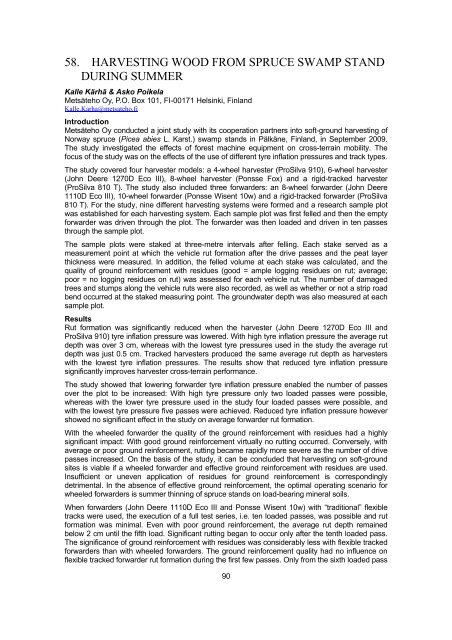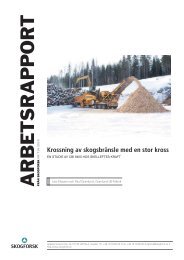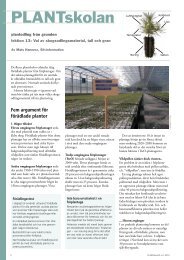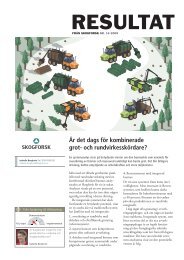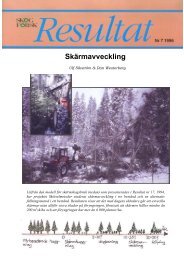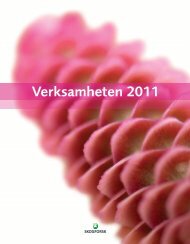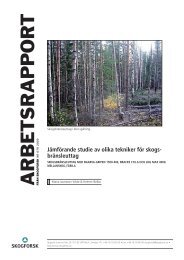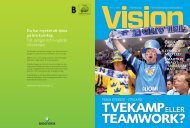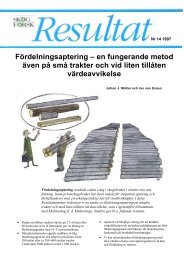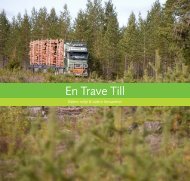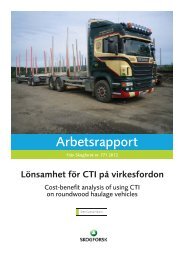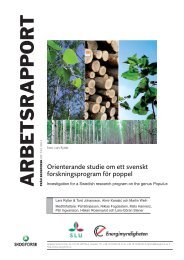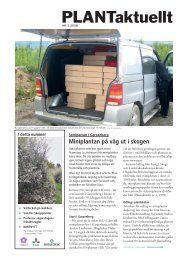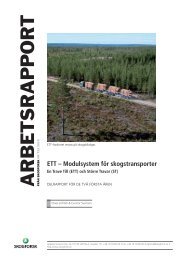Download pdf - Skog og landskap
Download pdf - Skog og landskap
Download pdf - Skog og landskap
Create successful ePaper yourself
Turn your PDF publications into a flip-book with our unique Google optimized e-Paper software.
58. HARVESTING WOOD FROM SPRUCE SWAMP STAND<br />
DURING SUMMER<br />
Kalle Kärhä & Asko Poikela<br />
Metsäteho Oy, P.O. Box 101, FI-00171 Helsinki, Finland<br />
Kalle.Karha@metsateho.fi<br />
Introduction<br />
Metsäteho Oy conducted a joint study with its cooperation partners into soft-ground harvesting of<br />
Norway spruce (Picea abies L. Karst.) swamp stands in Pälkäne, Finland, in September 2009.<br />
The study investigated the effects of forest machine equipment on cross-terrain mobility. The<br />
focus of the study was on the effects of the use of different tyre inflation pressures and track types.<br />
The study covered four harvester models: a 4-wheel harvester (ProSilva 910), 6-wheel harvester<br />
(John Deere 1270D Eco III), 8-wheel harvester (Ponsse Fox) and a rigid-tracked harvester<br />
(ProSilva 810 T). The study also included three forwarders: an 8-wheel forwarder (John Deere<br />
1110D Eco III), 10-wheel forwarder (Ponsse Wisent 10w) and a rigid-tracked forwarder (ProSilva<br />
810 T). For the study, nine different harvesting systems were formed and a research sample plot<br />
was established for each harvesting system. Each sample plot was first felled and then the empty<br />
forwarder was driven through the plot. The forwarder was then loaded and driven in ten passes<br />
through the sample plot.<br />
The sample plots were staked at three-metre intervals after felling. Each stake served as a<br />
measurement point at which the vehicle rut formation after the drive passes and the peat layer<br />
thickness were measured. In addition, the felled volume at each stake was calculated, and the<br />
quality of ground reinforcement with residues (good = ample l<strong>og</strong>ging residues on rut; average;<br />
poor = no l<strong>og</strong>ging residues on rut) was assessed for each vehicle rut. The number of damaged<br />
trees and stumps along the vehicle ruts were also recorded, as well as whether or not a strip road<br />
bend occurred at the staked measuring point. The groundwater depth was also measured at each<br />
sample plot.<br />
Results<br />
Rut formation was significantly reduced when the harvester (John Deere 1270D Eco III and<br />
ProSilva 910) tyre inflation pressure was lowered. With high tyre inflation pressure the average rut<br />
depth was over 3 cm, whereas with the lowest tyre pressures used in the study the average rut<br />
depth was just 0.5 cm. Tracked harvesters produced the same average rut depth as harvesters<br />
with the lowest tyre inflation pressures. The results show that reduced tyre inflation pressure<br />
significantly improves harvester cross-terrain performance.<br />
The study showed that lowering forwarder tyre inflation pressure enabled the number of passes<br />
over the plot to be increased: With high tyre pressure only two loaded passes were possible,<br />
whereas with the lower tyre pressure used in the study four loaded passes were possible, and<br />
with the lowest tyre pressure five passes were achieved. Reduced tyre inflation pressure however<br />
showed no significant effect in the study on average forwarder rut formation.<br />
With the wheeled forwarder the quality of the ground reinforcement with residues had a highly<br />
significant impact: With good ground reinforcement virtually no rutting occurred. Conversely, with<br />
average or poor ground reinforcement, rutting became rapidly more severe as the number of drive<br />
passes increased. On the basis of the study, it can be concluded that harvesting on soft-ground<br />
sites is viable if a wheeled forwarder and effective ground reinforcement with residues are used.<br />
Insufficient or uneven application of residues for ground reinforcement is correspondingly<br />
detrimental. In the absence of effective ground reinforcement, the optimal operating scenario for<br />
wheeled forwarders is summer thinning of spruce stands on load-bearing mineral soils.<br />
When forwarders (John Deere 1110D Eco III and Ponsse Wisent 10w) with “traditional” flexible<br />
tracks were used, the execution of a full test series, i.e. ten loaded passes, was possible and rut<br />
formation was minimal. Even with poor ground reinforcement, the average rut depth remained<br />
below 2 cm until the fifth load. Significant rutting began to occur only after the tenth loaded pass.<br />
The significance of ground reinforcement with residues was considerably less with flexible tracked<br />
forwarders than with wheeled forwarders. The ground reinforcement quality had no influence on<br />
flexible tracked forwarder rut formation during the first few passes. Only from the sixth loaded pass<br />
90


